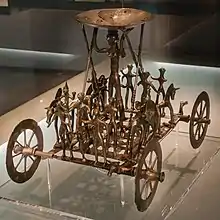Strettweg cult wagon
The Strettweg cult wagon, or Strettweg sacrificial wagon, or Strettweg chariot is a bronze cult wagon from ca. 600 BC, which was found as part of a princely grave of the Hallstatt culture in Strettweg near Judenburg, Austria in 1851. Besides the wagon, other grave goods, like jewelry, bronze amphorae, iron weapons, and horse tack were found.


The wagon consists of a square, open-worked base plate with four spoked wheels. A female figure approx. 32 cm high extending her hands to touch the base of a large bowl with tall, X-shaped supports. Expert analysis has concluded that the bowl cannot be conclusively proven to originally have been part of the cult wagon and may be a later addition. The wagon also contains numerous human figures, both standing and mounted, as well as animals similar to deer and horses. The scene has been interpreted as a sacrifice. The wagon presumably served as a cult object for the consumption of a libation.
The wagon was restored in 2009 and is on display in the Universalmuseum Joanneum at Eggenberg Palace, Graz. A copy is on display in the museum in Judenburg.
According to Marjeta Šašel-Kos (2000), "A deer goddess similar to Artemis must have played an important role in pre-Celtic Noricum, as is indicated by the cult cart from Strettweg, from c. 600 B.C., which represents a goddess (or her priestess) who received deer as a sacrifice, i.e. a kind of a 'Great Nature Goddess'."[1][2]
Gallery
References
- "Sacred Places and Epichoric Gods in the Southern Alpine Area - Some Aspects (Marjeta Šašel-Kos, 2000)". Ausonius Editions. 2000.
- "The votive chariot from Bujoru". capodopere2019.ro. 2019.
during the 7th c. BC is taking place a change as regards the religious practices at least for the Central Alpine and Eastern Sub-Alpine area (with the Hallstatt civilisation area), since the symbol of the water birds and the sun are gradually replaced by an anthropomorphic feminine figure, probably a deity of those time. In this respect, the miniature votive chariot from Strettweg is a pertinent example.
Literature
- Markus Egg: Neues zum Fürstengrab von Strettweg. 1991.
- Markus Egg, Gerhard Stawinoga: Das hallstattzeitliche Fürstengrab von Strettweg bei Judenburg in der Obersteiermark. Römisch-Germanisches Zentralmuseum, Forschungsinstitut für Vor- und Frühgeschichte, 1996, ISBN 3-88467-036-0


